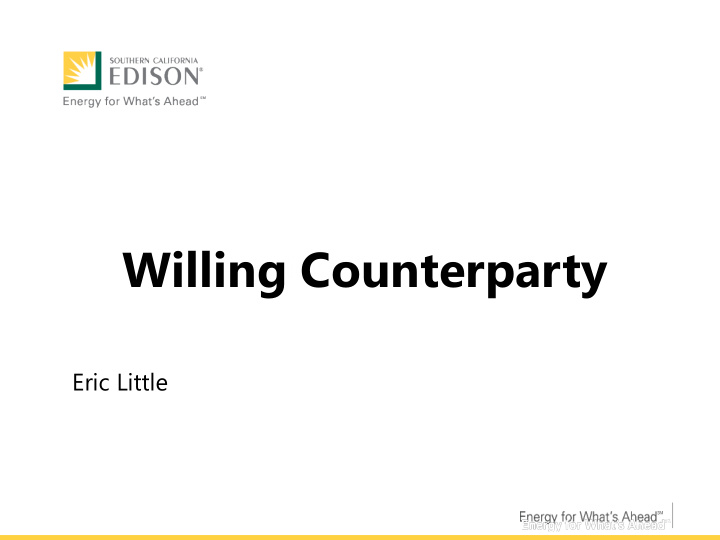



Willing Counterparty Eric Little
Al Allocation Proces ess • The allocation process would be largely unchanged • LSEs and Merchant Transmission nominate up to their seasonal or annual Eligible Quantity Includes both internal to the CAISO BAA LSEs (IOUs, DA, CCA, and • Municipalities) as well as OBAALSEs that have met their obligations to participate • Source and sink restrictions continue to apply consistent with the current tariff allocation rules • CAISO applies Simultaneous Feasibility Test accounting for grid conditions • Transfers to reflect load migration • CRRs for Merchant Transmission • Credit and collateral provisions are retained • Necessary modifications • Since unallocated CRRs are no longer auctioned, all unallocated CRRs contribute to the CRR Balancing Account for funding of allocated CRRs Under the willing counterparty proposal, there is no underfunding of CRRs for • those in the auction and therefore, neither the auction proceeds nor the monthly congestion activity will impact the CRR Balancing Account 2
Auc Auction P Process • Unallocated CRRs are not available for the auction process • Eliminates the CAISO acting as an agent to sell CRRs without regard to loads willingness to sell • The revenues and costs from these CRRs are placed in the CRR Balancing Account to address full funding for allocated CRRs • The same terms (annual and monthly, on and off-peak) are retained • All source sink nodes are available • Node, LAP , Sub-LAP , Scheduling Point, Trading Hub, etc. • Credit and Collateral provisions continue to apply • A CRR from source point A to sink point B will clear only to the extent a willing counterparty bids a CRR from a counter-flow in accordance with the Full Network Model • Methods may need to be developed to provide sufficient transparency of the sources and sinks that parties are willing to transact to provide for efficient trading (see next slide) 3
Transpa sparency cy f for willing g co counterpa party y transact ctions • Bulletin Board • A bulletin board with either binding or indicative offers could be created and posted prior to the auction giving parties an opportunity to identify CRRs available for purchase • Multi-Stage Auction • Implement an auction in which quantities and source-sink pairs are revealed after the first bidding round Informs the market of where there are offers to buy with no offer to sell in • order to inform bids in the following round • In a second round, additional bids could be provided with those bids and the bids from the first round then utilized to clear the market Would need to consider measures necessary to avoid gaming • • Exchange • CAISO modifies the auction to an exchange that could provide a place for parties to submit bids and offers prior to the operating period Timing of such a process as well as the allocation process would need to be • considered • Matches are made as they occur and CAISO settles between the two parties 4
Settlements • Allocation • Full funding provided through CRR Balancing Account as it is today • No auction revenues are credited to the CRR Balancing Account • Auction (including multi-stage)/Bulletin Board/Exchange • Full funding provided by counterparties • Auction buyer pays the clearing price and auction seller receives the clearing price • Monthly congestion subject to the CRR is paid by the counter-flow holding entity and received by the flow holding entity 5
Recommend
More recommend